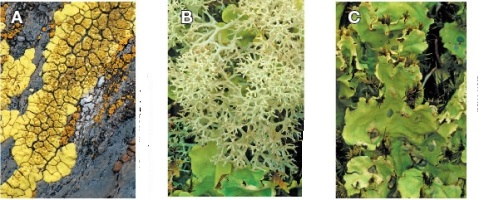Multiple Choice
Refer to the figure.  The figure shows three different types of lichen labeled A, B, and C.Which of these body forms would best suit a lichen contributing to new soil formation in rocky terrain; why?
The figure shows three different types of lichen labeled A, B, and C.Which of these body forms would best suit a lichen contributing to new soil formation in rocky terrain; why?
A) A; the lichen adheres tightly to its substrate and can acidify its surroundings to facilitate breakdown of inorganic materials.
B) B; the lichen acts as an ectomycorrhizal fungus and can provide nutrients to germinating seeds by encasing their roots, allowing them to grow and break down the rocks.
C) C; the lichen can trap airborne particles that will eventually collect in sufficient amounts to become soil.
D) A and C; these lichens can subsist on nutrients and minerals from the air and their photosynthetic partners, and over time they will die and become new soil.
E) B and C; these lichens can subsist on nutrients and minerals from the air and their photosynthetic partners, and over time they will die and become new soil.
Correct Answer:

Verified
Correct Answer:
Verified
Q1: Which event can never take place after
Q2: Under the right conditions, _ organize into
Q3: If speed of nutrient uptake is directly
Q4: Which of the following is an important
Q6: Microsporidia are<br>A) composed of dikaryotic and filamentous
Q7: _ are found in terrestrial, marine, and
Q8: Lichens can reproduce asexually by fragmentation of
Q9: Which of the following is not a
Q10: The gills of a mushroom are specialized
Q11: Assume that one haploid nucleus of a